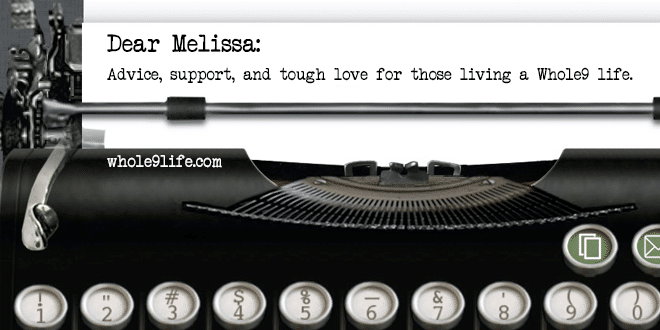Welcome to Dear Melissa, where I answer your questions about transitioning into or completing a Whole30, successfully sticking to your new healthy habits, and figuring out how to make this lifestyle work in the real world. Today, I’m helping a few of you figure out why you’re stuck in Kill All the Things mode, and what may be keeping you from Whole30 Tiger Blood. (Refer to page 32 in The Whole30 for details.)
Dear Melissa,
Question: will the “Kill All the Things” phase ever pass, and if so, when? I’m ready to lose it. It started for me on Day 3. I’m now on Day 15, and still want to bash everything in. Help, and thanks! –L.L., via Instagram
Dear L.L.,
As you’ve read in the Timeline chapter of The Whole30, the Kill All the Things phase usually occurs around Day 4-5, and is described like this:
“Day 4 dawns and you tentatively step out of bed… your head is surprisingly clear. Your limbs all feel functional. This could be a good day! You walk into the kitchen and as you’re greeted by the smiling face of your significant other you are suddenly overcome with the desire to punch them in the face for smiling this early in the morning. Congratulations! You’ve made it to day 4… Every nerve is lit, temperance is non-existent, and the only solution to the problem seems to be to Kill All of the Things.”
This irritability is really normal in the early stages of the Whole30, but it rarely last more than a day or two. For this to continue through the second week is very strange indeed, which makes me wonder what’s going on under your cranky, cranky hood. Without an in-depth questionnaire, it’s hard for me to know for sure, but here are a few guesses as to why you’re still feeling negative and short-tempered, and what might be keeping you from the Tiger Blood.
Change Your Focus
Have you spent the last two weeks focusing on all the stuff you can’t have? Thinking about everything you’re “missing out” on would make anyone crazy… and cranky. Your brain is already unhappy that you’ve been denying it the normal rewards it’s used to getting, and it doesn’t like being told “no.” And spending day after day thinking about everything you wish you could eat is only winding your brain up like a toddler who missed his nap.
Change Your Habits
Maybe you’re cranky because you’ve been feeding your Sugar Dragon for the last 15 days, giving into tantrums for rewarding foods with the sweetest, saltiest, fattiest foods you can find within the Whole30 construct. Except the stuff you’re eating now isn’t anywhere near as craving-satisfying as the candy/cookies/chips/treats you used to eat. And you’re probably feeling slightly out of control, giving into cravings automatically, and consuming beyond what feels good. Yeah, that’s enough to make anyone cranky.
Find Some Support
Perhaps you’re feeling cranky because you’re not getting the support you need from family and friends. You’re committed and motivated and really want to get excited about your Whole30, but it’s really hard to remain enthusiastic and positive in the face of criticism, ridicule, or downright sabotage. If you’re the only one doing the Whole30 in your household, well, that’s hard enough. You may feel isolated, alone, and unsupported. But if you’re facing active resistance from the people closest to you, it’s no wonder you’re reacting negatively. You may be imagining two more weeks of having to justify your choices, resist peer pressure, and miss out on family or friend-fun because the environment they’re creating just isn’t healthy for you.
Restore Your Energy
Finally, another explanation could be a matter of what you’re eating—not the kinds of foods, but how much, in what proportions, and how your body is adjusting to your new way of eating. It’s entirely possible, even on Day 15, that you’re still experiencing energy issues, either because you’re not eating enough in general, enough of the right stuff, or just struggling with the process of “fat adaption” (a process in which your cells learn how to use fat as fuel). The process starts in just a few days, but can take a few weeks to really kick in to the point that you notice a difference. Until then, you may be lethargic, craving, foggy, and yes… cranky.
In addition, many come to the Whole30 and under-eat. You’ve swapped out calorie-dense grains, legumes, and sugary processed foods with lower-calorie vegetables and fruit, and if you don’t make those calories up somewhere (protein, fat, starchier veggies, and fruit), you’re going to be under-fed. Or maybe you’re fat-phobic, undereating the macronutrient you’re trying to teach your body how to use. Or carb-phobic, eating tons of leafy greens, broccoli, and cauliflower and not eating enough potatoes, winter squash, or fruit to fuel your activity.
My final piece of advice? Be patient, and beg for patience from those around you. I promise, this, too, shall pass. Even though this phase is taking a little longer for you than it does for most, it won’t last forever, and once you get your Whole30 ducks in a row, you’ll be running straight to the Tiger Blood stage—to your relief, and the relief of your friends and family, I’m sure.
Best in health,
Melissa














